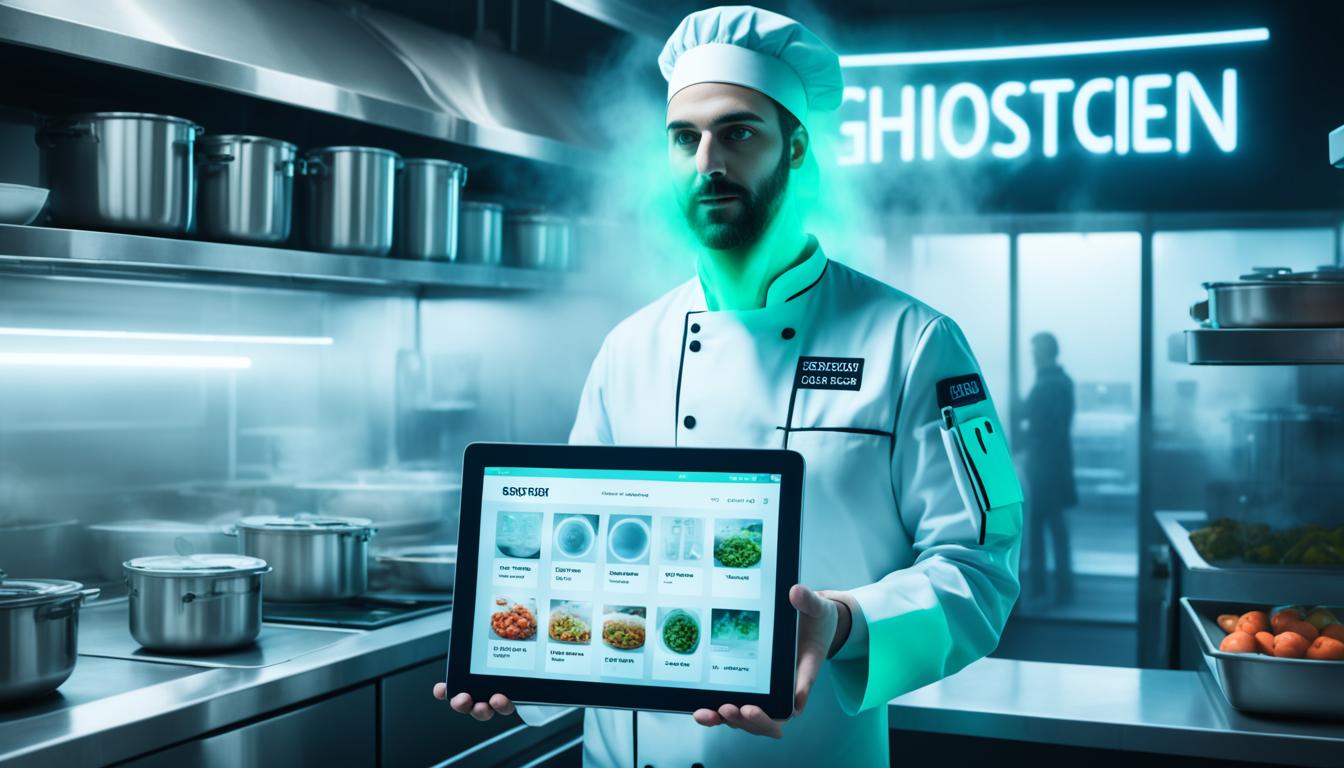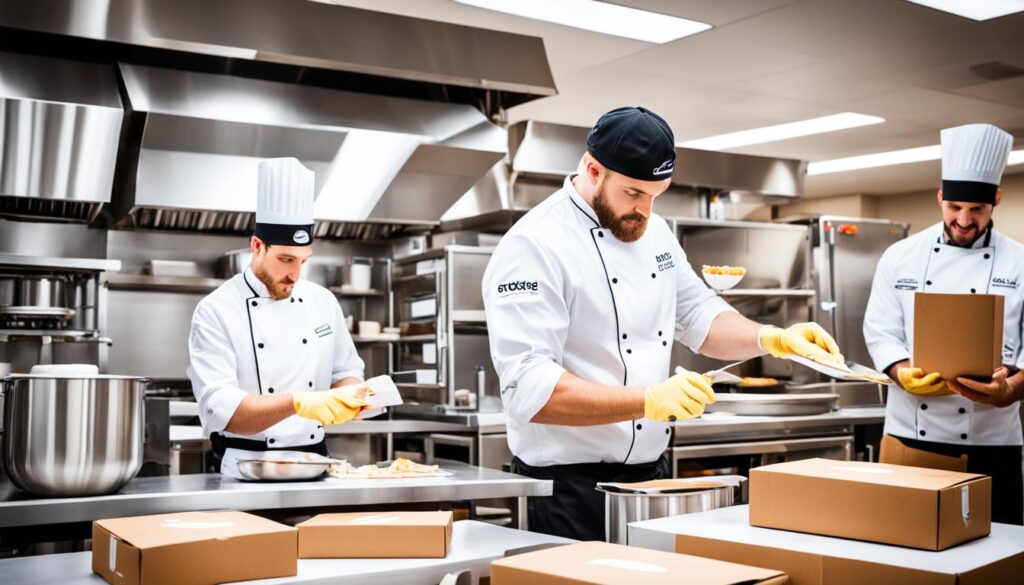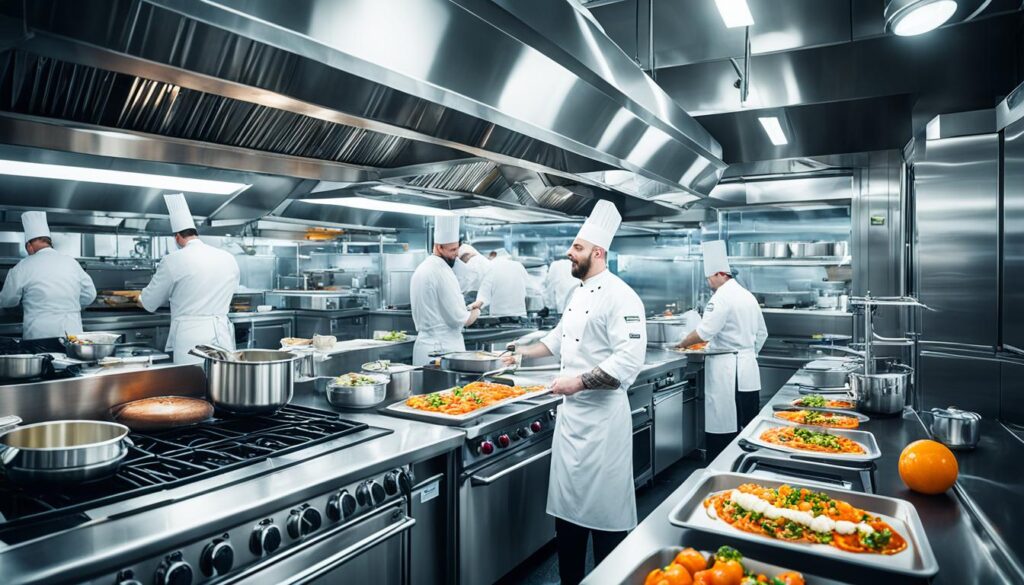Starting a Ghost Kitchen: Your Quick Guide

In this comprehensive guide, we will walk you through the essential steps to start a successful ghost kitchen. Whether you’re an experienced chef or a budding entrepreneur, we’ll provide you with valuable tips and insights on how to launch your own virtual kitchen and thrive in the online food delivery industry.
Key Takeaways:
- Starting a ghost kitchen can be a lucrative venture in the online food delivery industry.
- Ghost kitchens operate solely for delivery or takeout orders and don’t have a customer-facing space.
- Market research and identifying your niche are crucial for a profitable ghost kitchen.
- A well-crafted business plan and securing funding are essential for success.
- Choosing the right location and setting up an efficient kitchen space are important considerations.
Understanding the Concept of Ghost Kitchens
Before diving into the details, let’s begin by understanding what exactly a ghost kitchen is. Also referred to as virtual kitchens or cloud kitchens, ghost kitchens operate solely for delivery or takeout orders. These kitchens don’t have a dining area or customer-facing space and focus on preparing food for delivery through platforms like DoorDash or Uber Eats.
In today’s fast-paced digital world, the rise of ghost kitchens has become a game-changer for the food industry. With the increasing demand for online food delivery, ghost kitchens offer a cost-effective and efficient alternative to traditional brick-and-mortar restaurants. By eliminating the need for a physical dining space, restaurateurs can significantly reduce overhead costs while catering to the ever-growing online customer base.
Unlike traditional restaurants, ghost kitchens operate in a streamlined manner, driven solely by the online ordering and delivery ecosystem. By leveraging technology and optimizing operations, ghost kitchen owners can focus on what they do best – preparing delicious meals for their customers.
Benefits of Starting a Ghost Kitchen
Starting a ghost kitchen brings a multitude of benefits:
- Reduced Costs: Operating without the need for a physical storefront and dining area allows for significant savings in rent, utilities, and staffing expenses, making it an attractive option for entrepreneurs looking to enter the food industry with a lower financial barrier.
- Increased Flexibility: Ghost kitchens provide flexibility in terms of location, as they can be set up in areas with lower rent and higher demand for delivery services. This allows for greater accessibility to potential customers and helps maximize profits.
- Streamlined Operations: With a focus on fulfilling delivery or takeout orders, ghost kitchens streamline their operations to be highly efficient, reducing overheads and optimizing kitchen processes.
- Targeted Marketing: Online delivery platforms provide valuable customer data, allowing ghost kitchen owners to analyze customer preferences and target their marketing efforts effectively. This data-driven approach enables personalized promotions and menu offerings that cater to specific customer segments.
- Scalability: Ghost kitchens have the potential for rapid scaling and expansion since they are not limited by the constraints of physical space. As demand increases, owners can easily replicate their kitchen model in different locations or experiment with new concepts without the need for additional brick-and-mortar establishments.
Overview of the Steps Involved
Now that we’ve explored the concept and benefits of ghost kitchens, let’s take a high-level look at the steps involved in starting your own:
- Conduct Market Research and Identify Your Target Audience
- Develop a Solid Business Plan
- Secure Funding for Your Ghost Kitchen
- Find the Right Location
- Set Up an Efficient Kitchen Space
- Source High-Quality Ingredients and Build Supplier Relationships
- Develop a Mouthwatering Menu
- Create an Effective Marketing Strategy
- Streamline Operations and Provide Excellent Customer Service
Throughout this guide, we will delve into each of these steps in detail, providing you with valuable insights and practical tips to help you navigate the exciting journey of starting your own ghost kitchen.
Conducting Market Research and Identifying Your Niche
To ensure the success of your ghost kitchen, it’s crucial to conduct thorough market research and identify a profitable niche. Understanding customer preferences and market trends will enable you to tailor your menu and offerings to meet the demands of your target audience. Here are some essential steps to conduct effective market research and identify your niche:
Analyze the Market:
Start by analyzing the existing market for ghost kitchens in your area. Identify the competition, their offerings, and pricing strategies. Look for gaps or underserved areas where you can offer something unique and appealing.
Market Research Tip: Use online resources, industry reports, and local surveys to gather data and insights into the demand for online food delivery and ghost kitchen services. This information will help you make informed decisions when selecting your niche.
Understand Customer Preferences:
Get to know your target customers and their preferences. Conduct surveys or interviews to gather feedback and understand what types of cuisines and dishes they are most interested in. Pay attention to dietary restrictions, popular food trends, and local preferences.
Customer Preference Tip: Consider reaching out to potential customers through social media platforms or online food communities to gather insights directly from your target audience.
Select a Profitable Niche:
Based on your market research and customer preferences, it’s time to select a profitable niche for your ghost kitchen. Consider your culinary expertise, local demand, and the profitability of different cuisines. This will help you position your virtual restaurant for success.
Niche Selection Tip: Look for opportunities to cater to specific dietary needs or popular food trends, such as plant-based, gluten-free, or exotic cuisines that are not widely available in your area.
By conducting comprehensive market research and identifying a profitable niche, you’ll be able to design your menu offerings and business strategies to best serve your target customers.
| Benefits of Market Research and Niche Identification | Examples |
|---|---|
| Understanding customer preferences | Gathering feedback through surveys and interviews |
| Identifying gaps in the market | Researching local competition and their offerings |
| Creating a unique and appealing menu | Selecting a profitable niche based on market demand |
| Positioning your ghost kitchen for success | Catering to specific dietary needs or food trends |
Developing a Business Plan
A well-crafted business plan is essential for any new venture. When it comes to setting up a delivery-only kitchen or ghost kitchen, careful planning and strategic decision-making are key to success. In this section, we’ll discuss the key elements of a ghost kitchen business plan that will guide you towards establishing a thriving online kitchen.
Defining Your Target Market
One of the first steps in developing your ghost kitchen business plan is identifying your target market. Conduct market research to gain insights into the demographics, preferences, and ordering habits of your potential customers. This information will allow you to tailor your menu offerings and marketing strategies to cater specifically to your target audience.
Outlining Your Menu Offerings
The menu is the heart of your ghost kitchen. You need to carefully curate a selection of dishes that will appeal to your target market. Consider your culinary expertise, market trends, and local preferences when designing your menu. Offering a variety of options that cater to different dietary needs and preferences can help attract a wider customer base.
Establishing Pricing Strategies
Setting the right prices for your menu items is crucial to ensure profitability and competitiveness in the online food delivery industry. Consider factors such as ingredient costs, preparation time, and delivery fees when determining your pricing strategies. Additionally, analyzing your competitors’ pricing can provide valuable insights into the market and help you position your ghost kitchen appropriately.
Planning Your Marketing and Delivery Logistics
Marketing and delivery logistics are integral parts of your ghost kitchen business plan. Develop a comprehensive marketing strategy that includes online promotions, partnerships with food delivery platforms, and leveraging social media to reach your target audience. Additionally, establish efficient delivery logistics to ensure timely and reliable food delivery, enhancing customer satisfaction.
“A well-crafted business plan is like a roadmap that guides your ghost kitchen towards success. It helps you navigate through challenges, make informed decisions, and stay focused on your goals. Take the time to create a solid plan, and you’ll increase your chances of building a profitable delivery-only kitchen.”
With a well-developed business plan, you’ll have a clear direction and strategy for your ghost kitchen. It will serve as a foundation for your operations, marketing efforts, and decision-making processes. As you move forward in your journey to set up a delivery-only kitchen, keep revisiting and updating your business plan to adapt to changing market dynamics and customer preferences.
Securing Funding for Your Ghost Kitchen
Starting a ghost kitchen may require some initial investment. In this section, we’ll explore different funding options for your virtual kitchen, from self-financing to seeking loans from banks or investors. We’ll also provide tips on how to present your business plan to secure funding successfully.
Funding Options for Your Cloud Kitchen
When it comes to financing your ghost kitchen, there are several avenues you can explore:
- Self-financing: If you have personal savings or access to funds, you can choose to invest your own money into starting your ghost kitchen. This option allows you to maintain full control over your business, but it may limit your available capital.
- Bank loans: Many entrepreneurs opt to apply for loans from banks to fund their cloud kitchen ventures. To increase your chances of approval, ensure you have a well-developed business plan and financial projections that demonstrate the profitability of your concept.
- Investors: Venture capitalists and angel investors are always on the lookout for promising business opportunities. Pitching your ghost kitchen idea to potential investors can help you secure the financial backing you need to get your virtual kitchen off the ground. Be prepared to present a compelling case, highlighting the potential profitability and scalability of your concept.
- Crowdfunding: Crowdfunding platforms provide an alternative way to raise funds for your ghost kitchen. By sharing your business idea and passion with the public, you can attract individuals who are interested in supporting your project.
Tips for Successful Funding Presentations
Securing funding for your ghost kitchen requires convincing potential lenders or investors that your business is a worthwhile investment. Here are some tips to help you make a compelling funding presentation:
- Prepare a comprehensive business plan: Your business plan should outline your ghost kitchen concept, target market, competitive analysis, financial projections, and marketing strategy. It should clearly demonstrate the potential for profitability and growth.
- Showcase your expertise: Highlight your culinary experience, previous successes, and unique selling proposition. Investors want to know that you have the knowledge and skills to make your ghost kitchen a success.
- Focus on your target market: Emphasize the size and potential of your target market, showcasing how your ghost kitchen fills a gap or meets customer needs that are not currently being addressed.
- Highlight your competitive advantage: Identify what sets your ghost kitchen apart from the competition. Whether it’s a unique menu, innovative technology, or a strong brand, make sure to highlight the factors that give you an edge.
- Present a thorough financial plan: Provide detailed financial projections that include start-up costs, operational expenses, revenue forecasts, and projected profitability. This will help potential investors see the financial viability of your ghost kitchen.

Finding the Right Location
When launching a digital kitchen, finding the right location may not involve physical space, but it’s still a critical decision. While ghost kitchens don’t require a traditional storefront, selecting the optimal location can greatly impact the success of your venture. In this section, we’ll explore the key factors to consider when choosing a location for your ghost kitchen.
Proximity to Target Customers
One of the primary considerations when selecting a location for your ghost kitchen is the proximity to your target customers. Analyze the demographics and preferences of your target audience to identify areas where there is a high demand for online food delivery. By locating your kitchen close to your customer base, you can minimize delivery times, ensuring hot and fresh meals reach your customers in a timely manner.
Accessibility to Delivery Drivers
Another crucial factor to consider is the accessibility of your ghost kitchen to delivery drivers. Easy accessibility will allow drivers from various delivery platforms to pick up orders efficiently, reducing wait times and ensuring prompt deliveries. Look for a location that offers convenient access to main roads and highways, making it easier for drivers to navigate and reach their destinations swiftly.
Availability of Necessary Infrastructure
Ensure that the location you choose provides the necessary infrastructure for your ghost kitchen operations. This includes access to reliable electricity, water supply, and internet connectivity. In addition, consider any specific requirements you may have, such as refrigeration and ventilation systems, to ensure your kitchen can meet food safety standards while efficiently handling a high volume of orders.
“Choosing the right location is essential for a digital kitchen’s success. The proximity to customers, accessibility to delivery drivers, and availability of infrastructure are critical factors to consider.”
By carefully evaluating these factors, you can select a location that optimizes your ghost kitchen’s efficiency, ensures customer satisfaction, and supports the growth of your digital culinary venture.
Setting Up an Efficient Kitchen Space
Creating a functional and efficient kitchen space is essential for maximizing productivity and ensuring smooth operations in your ghost kitchen. The right kitchen layout, equipment selection, and workflow optimization can significantly impact your success in the online food delivery industry.
When designing the layout of your ghost kitchen, consider factors such as space utilization, workflow efficiency, and safety. Here are some key strategies to keep in mind:
- Organize your kitchen into distinct work zones, such as prep, cooking, and plating, to minimize clutter and streamline operations.
- Place frequently used equipment and ingredients within arm’s reach to minimize movement and save time.
- Optimize the flow of work by positioning stations in a logical sequence, ensuring a smooth transition from one task to another.
- Invest in high-quality storage solutions, such as shelving units and containers, to keep ingredients organized and easily accessible.
- Implement food safety protocols, including proper storage and labeling, to maintain hygiene standards and ensure compliance with regulations.
Equipment Selection
Choosing the right equipment for your ghost kitchen is crucial for optimizing productivity and maintaining consistency in food preparation. Consider the following tips:
- Assess your menu and determine the specific equipment needed for each item. Invest in versatile appliances that can handle multiple tasks.
- Research reputable suppliers and brands to ensure quality and durability.
- Consider energy-efficient equipment to minimize operational costs.
- Regularly maintain and calibrate your equipment to extend their lifespan and prevent breakdowns.
- Stay informed about the latest advancements in kitchen technology to continuously improve efficiency.
Optimizing Workflow
A well-optimized workflow is essential for ensuring smooth operations in your ghost kitchen. Here are some strategies to enhance your workflow efficiency:
- Create standardized recipes and preparation guidelines to maintain consistency and minimize errors.
- Train your staff to follow efficient work procedures, reducing wait times and improving overall productivity.
- Implement a digital order management system to streamline the order flow and reduce manual errors.
- Regularly review and adjust your workflow based on customer feedback and operational insights.
By applying these ghost kitchen success strategies, you can create an efficient kitchen space that maximizes productivity, enhances food quality, and ensures the smooth operation of your virtual kitchen.

| Benefits of an Efficient Kitchen Space: | Challenges of an Inefficient Kitchen Space: |
|---|---|
| Increased productivity and faster order fulfillment | Slower food preparation and longer wait times |
| Consistent food quality and portion control | Inconsistent food quality and portion sizes |
| Reduced operational costs through efficient energy usage | Higher energy bills due to wasteful practices |
| Improved staff morale and job satisfaction | Increased staff stress and frustration |
Sourcing High-Quality Ingredients and Building Supplier Relationships
In the ghost kitchen business, the quality of your ingredients plays a crucial role in the success of your culinary creations. By sourcing high-quality ingredients and building strong relationships with reliable suppliers, you can ensure that your ghost kitchen delivers top-notch meals that keep customers coming back for more. Here are some essential tips for finding the best ingredients and establishing fruitful partnerships with suppliers:
-
Research Local Suppliers: Start by researching local farms, distributors, and wholesalers in your area. Look for suppliers that prioritize quality, freshness, and sustainability in their offerings. Make a list of potential suppliers that align with your ingredient requirements and culinary vision.
-
Attend Industry Events: Attend food and restaurant industry events, such as farmer’s markets, trade shows, and networking events. These events provide an excellent opportunity to meet suppliers, sample their products, and discuss potential partnerships. Networking with industry professionals can open doors to high-quality ingredients and valuable supplier connections.
-
Request Samples: When considering potential suppliers, don’t hesitate to request samples of their products. By trying out the ingredients firsthand, you can evaluate their quality, taste, and suitability for your ghost kitchen’s menu. Sampling allows you to make informed decisions and choose ingredients that will elevate the flavors of your dishes.
-
Compare Prices and Terms: As a ghost kitchen operator, it’s essential to strike a balance between quality and affordability. Compare prices from different suppliers to ensure you’re getting the best value for your budget. Additionally, discuss the terms and conditions with potential suppliers, including delivery schedules, minimum order quantities, and payment terms.
-
Establish Long-Term Relationships: Building strong relationships with trustworthy suppliers is key to maintaining a consistent supply of high-quality ingredients. Communicate openly with your suppliers, provide feedback on their products, and discuss any specific requirements or changes in your menu. By nurturing these relationships, you’ll be able to overcome challenges and work together to create exceptional culinary experiences.
Remember, the quality of your ingredients is the foundation of your ghost kitchen’s reputation. By sourcing the best ingredients and establishing strong supplier relationships, you can ensure that your virtual kitchen delivers meals that exceed customer expectations.
Key Factors to Consider when Sourcing Ingredients
| Factors | Considerations |
|---|---|
| Quality | Opt for fresh, high-quality ingredients that meet your ghost kitchen’s standards |
| Sustainability | Choose suppliers who prioritize sustainable farming practices and environmentally friendly packaging |
| Seasonality | Consider the availability of ingredients based on seasonal variations |
| Price | Compare prices across suppliers to find the best balance of quality and affordability |
| Delivery | Ensure reliable and timely delivery schedules to maintain ingredient freshness |
| Specialty Items | Identify suppliers who can provide specialty or unique ingredients for your signature dishes |
Developing a Mouthwatering Menu
Your menu is the heart of your ghost kitchen. It’s essential to craft a selection of dishes that not only tantalize taste buds but also reflects your culinary expertise and appeals to your target market. In this section, we’ll explore some menu development strategies to help you create a mouthwatering menu that will keep customers coming back for more.
Analyze Customer Preferences
Understanding your target audience’s preferences is crucial when developing your menu. Conduct market research, analyze customer feedback, and take note of popular food trends in your area. Identifying what your customers love and want will guide you in selecting the right dishes to offer.
Incorporate Popular Trends
Stay up-to-date with the latest food trends and incorporate them into your menu. Whether it’s plant-based options, gluten-free alternatives, or unique fusion cuisines, catering to popular trends can attract a wider customer base and set your virtual kitchen apart from the competition.
“By continuously updating our menu to include trending flavors and exciting culinary fusions, we’ve been able to attract a diverse range of customers who are always eager to try something new.”
– Chef Emily Thompson, owner of Fusion Bites
Ensure a Well-Balanced Selection
A well-balanced menu offers a variety of flavors, textures, and dietary options. Include a mix of appetizers, main courses, sides, and desserts. Consider offering vegetarian, vegan, and gluten-free options to cater to different dietary needs. It’s important to provide something for everyone.
“Having a well-balanced menu allows us to cater to a wider audience. We’ve seen an increase in orders from customers who appreciate having options that suit their dietary preferences.”
– Chef Marcus Lopez, owner of Healthy Bites
Remember to regularly review and evolve your menu based on customer feedback and changing trends. By constantly refining your offerings, you can keep your menu fresh and exciting, ensuring that your virtual kitchen remains a go-to destination for food lovers.
Next, in Section 10, we’ll discuss the importance of marketing and promoting your ghost kitchen to attract customers and drive online orders.
Marketing and Promoting Your Ghost Kitchen
Effective marketing is crucial for reaching and attracting customers to your ghost kitchen. In this section, we’ll discuss various strategies to promote and market your virtual kitchen, ensuring maximum visibility and increasing orders.
1. Online Marketing Strategies
Utilize the power of online marketing to enhance the reach of your ghost kitchen. Here are some effective strategies:
- Create a user-friendly website that showcases your menu, highlights your unique selling points, and offers easy online ordering.
- Optimize your website with relevant keywords and provide engaging and informative content to improve search engine visibility.
- Set up online profiles on popular food delivery platforms such as DoorDash, Uber Eats, and Grubhub to expand your customer base.
- Invest in targeted online advertising campaigns, such as pay-per-click (PPC) ads and social media ads, to reach potential customers.
2. Social Media Promotion
Social media platforms offer immense opportunities to connect with your target audience and promote your ghost kitchen. Consider the following tips:
- Create business pages on social media platforms like Facebook, Instagram, and Twitter.
- Share visually appealing images and videos of your food presentations to entice potential customers.
- Engage with your audience by responding to comments and messages promptly.
- Run social media contests or giveaway campaigns to incentivize customers to order from your virtual kitchen.
3. Collaboration with Food Influencers
Partnering with food influencers can significantly boost the visibility of your ghost kitchen. Consider the following collaboration options:
- Identify local food influencers with a significant following and engage in collaborative activities.
- Offer free meals or discounts to food influencers in exchange for genuine reviews and social media mentions.
- Organize food tasting events or influencer meet-ups at your ghost kitchen to generate buzz and attract attention.
4. Leveraging Customer Reviews
Positive customer reviews play a vital role in building trust and attracting new customers to your ghost kitchen. Consider these tips:
- Encourage customers to leave reviews on your website, social media platforms, or popular review sites like Yelp.
- Respond to both positive and negative reviews in a professional manner, demonstrating your commitment to customer satisfaction.
- Showcase positive reviews on your website and social media platforms to build credibility and trust among potential customers.
Online Marketing Channels
| Channel | Description |
|---|---|
| Website | Showcases menu, offers online ordering, and provides information about your ghost kitchen. |
| Food Delivery Platforms | Partner with popular platforms like DoorDash, Uber Eats, and Grubhub to reach a wider customer base. |
| Social Media | Engage with your audience, share updates and promotions, and build a loyal following. |
| Online Advertising | Invest in targeted online advertising campaigns, including PPC ads and social media ads. |
| Email Marketing | Build an email list and send newsletters and promotional offers to past and potential customers. |
Managing Operations and Providing Excellent Customer Service
Running a successful ghost kitchen requires more than just preparing delicious food. It’s essential to prioritize efficient operations and deliver exceptional customer service. By implementing the right strategies and focusing on ghost kitchen success strategies, you can ensure smooth order management, streamline delivery logistics, train your staff effectively, and maintain consistency in your services.
To optimize your operations, consider investing in an order management system specifically designed for ghost kitchens. This software can help you efficiently process incoming orders, track inventory, and manage delivery partners. With real-time data and automated processes, you can minimize errors, maximize efficiency, and provide customers with a seamless ordering experience.
Delivery logistics play a crucial role in the success of your ghost kitchen. Ensure that you have a reliable network of delivery partners or consider establishing your own in-house delivery fleet. Optimize routes, track deliveries in real-time, and provide accurate delivery estimates to manage customer expectations effectively.
Dedicate time and resources to train your staff on not only food preparation techniques but also customer service skills. Regardless of whether you interact with customers directly or not, every member of your team should be equipped with the knowledge and skills to provide excellent customer service.
To deliver exceptional customer service, maintaining consistency is key. Ensure that every order meets your standards by emphasizing rigorous quality control measures. Create standardized recipes, establish portion control guidelines, and implement regular quality checks to maintain the consistency of your dishes.
Summary
Managing operations and providing excellent customer service are integral to the success of your ghost kitchen. By utilizing an order management system, optimizing delivery logistics, training your staff, and maintaining consistency, you can deliver a superior customer experience and build a loyal customer base.
Conclusion
In conclusion, starting a ghost kitchen can be a lucrative venture for aspiring chefs and entrepreneurs looking to capitalize on the growing demand for online food delivery. By following the comprehensive guide provided in this article, you’ll gain valuable insights and practical tips to set up and run a successful virtual kitchen.
Remember, careful planning is key. Conduct thorough market research, identify a profitable niche, and develop a well-crafted business plan that encompasses your target market, menu offerings, pricing strategies, and marketing tactics.
Additionally, pay attention to crucial aspects such as location selection, creating an efficient kitchen space, sourcing high-quality ingredients, and designing a mouthwatering menu. Promote your ghost kitchen through effective online marketing strategies and ensure seamless operations and outstanding customer service.
By combining the right ingredients of passion, strategy, and diligence, you’ll be on your way to launching a profitable and thriving online kitchen that caters to the evolving needs and preferences of today’s digital-savvy consumers.







